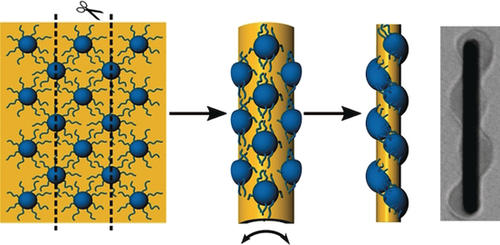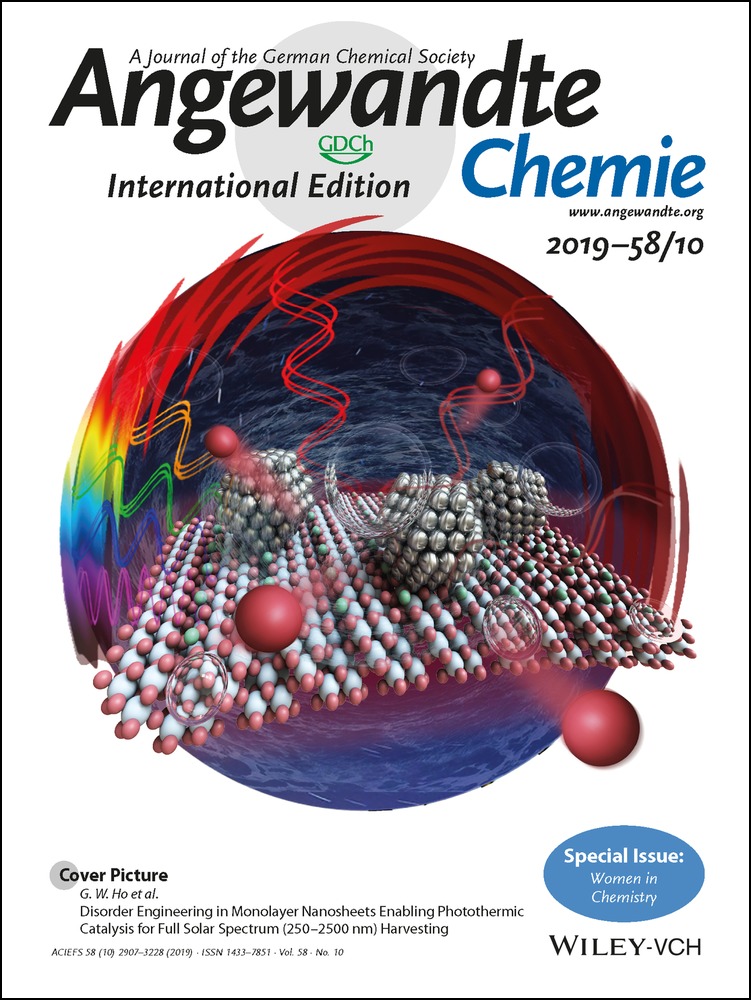Helicoidal Patterning of Nanorods with Polymer Ligands
Elizabeth Galati
Department of Chemistry, University of Toronto, Toronto, ON, M5S 3H6 Canada
Search for more papers by this authorHuachen Tao
Department of Chemistry, University of Toronto, Toronto, ON, M5S 3H6 Canada
Search for more papers by this authorMoritz Tebbe
Department of Chemistry, University of Toronto, Toronto, ON, M5S 3H6 Canada
Search for more papers by this authorRija Ansari
Department of Chemistry, University of Toronto, Toronto, ON, M5S 3H6 Canada
Search for more papers by this authorProf. Michael Rubinstein
Department of Mechanical Engineering and Materials Science, Biomedical Engineering, Physics and Chemistry, Duke University, Durham, NC, 27708 USA
Search for more papers by this authorCorresponding Author
Dr. Ekaterina B. Zhulina
Institute of Macromolecular Compounds of the Russian Academy of Sciences, Saint Petersburg, 199004 Russia
Search for more papers by this authorCorresponding Author
Prof. Eugenia Kumacheva
Department of Chemistry, University of Toronto, Toronto, ON, M5S 3H6 Canada
Institute of Biomaterials and Biomedical Engineering, Toronto, ON, M5S 3G9 Canada
Department of Chemical Engineering and Applied Chemistry, University of Toronto, Toronto, ON, M5S 3E5 Canada
Search for more papers by this authorElizabeth Galati
Department of Chemistry, University of Toronto, Toronto, ON, M5S 3H6 Canada
Search for more papers by this authorHuachen Tao
Department of Chemistry, University of Toronto, Toronto, ON, M5S 3H6 Canada
Search for more papers by this authorMoritz Tebbe
Department of Chemistry, University of Toronto, Toronto, ON, M5S 3H6 Canada
Search for more papers by this authorRija Ansari
Department of Chemistry, University of Toronto, Toronto, ON, M5S 3H6 Canada
Search for more papers by this authorProf. Michael Rubinstein
Department of Mechanical Engineering and Materials Science, Biomedical Engineering, Physics and Chemistry, Duke University, Durham, NC, 27708 USA
Search for more papers by this authorCorresponding Author
Dr. Ekaterina B. Zhulina
Institute of Macromolecular Compounds of the Russian Academy of Sciences, Saint Petersburg, 199004 Russia
Search for more papers by this authorCorresponding Author
Prof. Eugenia Kumacheva
Department of Chemistry, University of Toronto, Toronto, ON, M5S 3H6 Canada
Institute of Biomaterials and Biomedical Engineering, Toronto, ON, M5S 3G9 Canada
Department of Chemical Engineering and Applied Chemistry, University of Toronto, Toronto, ON, M5S 3E5 Canada
Search for more papers by this authorGraphical Abstract
Abstract
Chiral packing of ligands on the surface of nanoparticles (NPs) is of fundamental and practical importance, as it determines how NPs interact with each other and with the molecular world. Herein, for gold nanorods (NRs) capped with end-grafted nonchiral polymer ligands, we show a new mechanism of chiral surface patterning. Under poor solvency conditions, a smooth polymer layer segregates into helicoidally organized surface-pinned micelles (patches). The helicoidal morphology is dictated by the polymer grafting density and the ratio of the polymer ligand length to nanorod radius. Outside this specific parameter space, a range of polymer surface structures was observed, including random, shish-kebab, and hybrid patches, as well as a smooth polymer layer. We characterize polymer surface morphology by theoretical and experimental state diagrams. The helicoidally organized polymer patches on the NR surface can be used as a template for the helicoidal organization of other NPs, masked synthesis on the NR surface, as well as the exploration of new NP self-assembly modes.
Supporting Information
As a service to our authors and readers, this journal provides supporting information supplied by the authors. Such materials are peer reviewed and may be re-organized for online delivery, but are not copy-edited or typeset. Technical support issues arising from supporting information (other than missing files) should be addressed to the authors.
| Filename | Description |
|---|---|
| anie201812887-sup-0001-misc_information.pdf2.5 MB | Supplementary |
Please note: The publisher is not responsible for the content or functionality of any supporting information supplied by the authors. Any queries (other than missing content) should be directed to the corresponding author for the article.
References
- 1W. Ma, L. Xu, A. F. De Moura, X. Wu, H. Kuang, C. Xu, N. A. Kotov, Chem. Rev. 2017, 117, 8041–8093.
- 2I. Dolamic, S. Knoppe, A. Dass, T. Bürgi, Nat. Commun. 2012, 3, 798.
- 3C. Gautier, T. Bürgi, ChemPhysChem 2009, 10, 483–492.
- 4T. G. Schaaff, G. Knight, M. N. Shafigullin, R. F. Borkman, R. L. Whetten, J. Phys. Chem. B 1998, 102, 10643–10646.
- 5C. Gautier, T. Bürgi, J. Am. Chem. Soc. 2006, 128, 11079–11087.
- 6F. Lu, Y. Tian, M. Liu, D. Su, H. Zhang, A. O. Govorov, O. Gang, Nano Lett. 2013, 13, 3145–3151.
- 7J. M. Slocik, A. O. Govorov, R. R. Naik, Nano Lett. 2011, 11, 701–705.
- 8D. F. Holmes, C. J. Gilpin, C. Baldock, U. Ziese, A. J. Koster, K. E. Kadler, Proc. Natl. Acad. Sci. USA 2001, 98, 7307–7312
- 9G. D. Lilly, A. Agarwal, S. Srivastava, N. A. Kotov, Small 2011, 7, 2004–2009.
- 10W. Ma, H. Kuang, L. Xu, L. Ding, C. Xu, L. Wang, N. A. Kotov, Nat. Commun. 2013, 4, https://doi.org/10.1038/ncomms3689.
- 11J. Lu, Y. X. Chang, N. N. Zhang, Y. Wei, A. J. Li, J. Tai, Y. Xue, Z. Y. Wang, Y. Yang, L. Zhao, et al., ACS Nano 2017, 11, 3463–3475.
- 12Y. Li, J. J.-Y. Suen, E. Prince, E. M. Larin, A. Klinkova, H. Thérien-Aubin, S. Zhu, B. Yang, A. S. Helmy, O. D. Lavrentovich, et al., Nat. Commun. 2016, 7, https://doi.org/10.1038/ncomms12520.
- 13A. Ben-Moshe, S. G. Wolf, M. B. Sadan, L. Houben, Z. Fan, A. O. Govorov, G. Markovich, Nat. Commun. 2014, 5, https://doi.org/10.1038/ncomms5302.
- 14J. Yeom, B. Yeom, H. Chan, K. W. Smith, S. Dominguez-Medina, J. H. Bahng, G. Zhao, W. S. Chang, S. J. Chang, A. Chuvilin, et al., Nat. Mater. 2015, 14, 66–72.
- 15H. E. Lee, H. Y. Ahn, J. Mun, Y. Y. Lee, M. Kim, N. H. Cho, K. Chang, W. S. Kim, J. Rho, K. T. Nam, Nature 2018, 556, 360–364.
- 16T. Nakashima, Y. Kobayashi, T. Kawai, J. Am. Chem. Soc. 2009, 131, 10342–10343.
- 17V. Humblot, S. Haq, C. Muryn, W. A. Hofer, R. Raval, J. Am. Chem. Soc. 2002, 124, 503–510.
- 18Y. Li, D. Yu, L. Dai, A. Urbas, Q. Li, Langmuir 2011, 27, 98–103.
- 19E. Bianchi, R. Blaak, C. N. Likos, Phys. Chem. Chem. Phys. 2011, 13, 6397.
- 20B. D. Marshall, Soft Matter 2017, 13, 6506–6514.
- 21C. Singh, P. K. Ghorai, M. A. Horsch, A. M. Jackson, R. G. Larson, F. Stellacci, S. C. Glotzer, Phys. Rev. Lett. 2007, 99, 1–4.
- 22C. Rossner, Q. Tang, M. Müller, G. Kothleitner, Soft Matter 2018, 14, 4551–4557.
- 23R. M. Choueiri, E. Galati, H. Thérien-Aubin, A. Klinkova, E. M. Larin, A. Querejeta-Fernández, L. Han, H. L. Xin, O. Gang, E. B. Zhulina, et al., Nature 2016, 538, 79–83.
- 24E. B. Zhulina, T. M. Birshtein, V. A. Priamitsyn, L. I. Klushin, Macromolecules 1995, 28, 8612–8620.
- 25R. M. Choueiri, A. Klinkova, S. Pearce, I. Manners, E. Kumacheva, Macromol. Rapid Commun. 2018, 39, 1700554.
- 26E. Galati, M. Tebbe, A. Querejeta-Fernández, H. L. Xin, O. Gang, E. B. Zhulina, E. Kumacheva, ACS Nano 2017, 11, 4995–5002.
- 27M. R. Jones, R. J. Macfarlane, A. E. Prigodich, P. C. Patel, C. A. Mirkin, J. Am. Chem. Soc. 2011, 133, 18865–18869.
- 28D. A. Walker, E. K. Leitsch, R. J. Nap, I. Szleifer, B. A. Grzybowski, Nat. Nanotechnol. 2013, 8, 676–681.
- 29G. Nerlich, Shape Sp., Press Syndics Of University Of Cambridge, Cambridge, 1994, pp. 76–80.
- 30E. Gonzalez Solveyra, M. Tagliazucchi, I. Szleifer, Faraday Discuss. 2016, 191, 351–372.
- 31N. Cathcart, P. Mistry, C. Makra, B. Pietrobon, N. Coombs, M. Jelokhani-Niaraki, V. Kitaev, Langmuir 2009, 25, 5840–5846.
- 32M. J. Bierman, Y. K. A. Lau, A. V. Kvit, A. L. Schmitt, S. Jin, Science 2008, 320, 1060–1063.
- 33Y. Wang, Q. Wang, H. Sun, W. Zhang, G. Chen, Y. Wang, X. Shen, Y. Han, X. Lu, H. Chen, J. Am. Chem. Soc. 2011, 133, 20060–20063.
- 34Z. Wang, B. He, G. Xu, G. Wang, J. Wang, Y. Feng, D. Su, B. Chen, H. Li, Z. Wu, et al., Nat. Commun. 2018, 9, 563.
- 35N. A. Abdulrahman, Z. Fan, T. Tonooka, S. M. Kelly, N. Gadegaard, E. Hendry, A. O. Govorov, M. Kadodwala, Nano Lett. 2012, 12, 977–983.
- 36Z. Li, Z. Zhu, W. Liu, Y. Zhou, B. Han, Y. Gao, Z. Tang, J. Am. Chem. Soc. 2012, 134, 3322–3325.
- 37H. Husu, B. K. Canfield, J. Laukkanen, B. Bai, M. Kuittinen, J. Turunen, M. Kauranen, Appl. Phys. Lett. 2008, 93, 183115.
- 38M. Tebbe, E. Galati, G. C. Walker, E. Kumacheva, Small 2017, 13, 1702043.
- 39A. Sánchez-Iglesias, N. Winckelmans, T. Altantzis, S. Bals, M. Grzelczak, L. M. Liz-Marzán, J. Am. Chem. Soc. 2017, 139, 107–110.
- 40N. R. Jana, L. Gearheart, C. J. Murphy, J. Phys. Chem. B 2001, 105, 4065–4067.
- 41The pentatwinned geometry of the NRs was assumed to be screened by the long polymer ligands with respects to the NR radius.
- 42M. Mayer, L. Scarabelli, K. March, T. Altantzis, M. Tebbe, M. Kociak, S. Bals, F. J. Garciá De Abajo, A. Fery, L. M. Liz-Marzán, Nano Lett. 2015, 15, 5427–5437.
- 43K. Park, H. Koerner, R. A. Vaia, Nano Lett. 2010, 10, 1433–1439.
- 44R. M. Rubinstein, M. Colby, Polymer Physics, Oxford University Press, Oxford, 2006.
- 45G. V. Schulz, H. Baumann, Makromol. Chem. 1968, 114, 122–138.
- 46Z. Nie, D. Fava, E. Kumacheva, S. Zou, G. C. Walker, M. Rubinstein, Nat. Mater. 2007, 6, 609–614.
- 47B. A. Wolf, G. Blaum, Makromol. Chem. 1978, 179, 2265–2277.





